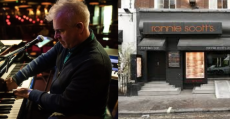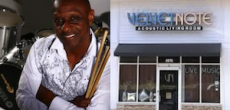
The Jazz Voyager
Feel the soul of New Orleans come alive as Grammy winner Adonis Rose and the New Orleans Jazz Orchestra present Sacred Spaces, a powerful ballet that blends music and dance in a celebration of resilience, community, and hope. Created in collaboration with the renowned Cleo Parker Robinson Dance Company, the piece was inspired by the burning of three historic Black churches in Louisiana.
With gospel, funeral dirges, and second lines woven throughout, this unforgettable performance transforms tragedy into a stirring tribute to healing and strength and features vocalist Andromeda Turre.
Performance Lineup: Adonis Rose, drums / Artistic Director Andromeda Turre, vocals David Navarro, trumpet Miles Berry, tenor saxophone itch Butler, trombone Brandon McCune, piano
Tickets: $25.00 ~ $50.00
More Posts: adventure,club,drums,ensembles,genius,jazz,music,preserving,travel,vocal

ADONIS ROSE & NOJO
Feel the soul of New Orleans come alive as Grammy winner Adonis Rose and the New Orleans Jazz Orchestra present Sacred Spaces, a powerful ballet that blends music and dance in a celebration of resilience, community, and hope. Created in collaboration with the renowned Cleo Parker Robinson Dance Company, the piece was inspired by the burning of three historic Black churches in Louisiana.
With gospel, funeral dirges, and second lines woven throughout, this unforgettable performance transforms tragedy into a stirring tribute to healing and strength and features vocalist Andromeda Turre.
Performance Lineup:
Adonis Rose, drums / Artistic Director
Andromeda Turre, vocals
David Navarro, trumpet
Miles Berry, tenor saxophone
itch Butler, trombone
Brandon McCune, piano
Tickets: $25.00 ~ $50.00
More Posts: adventure,bandleader,club,drums,genius,instrumental,jazz,music,preserving,travel,vocal

JOHNATHAN BLAKE
Drummer-composer Johnathan Blake returns to Ronnie Scott’s with music from his powerful new Blue Note album My Life Matters. Originally commissioned by The Jazz Gallery, the suite is both personal and political – a reflection on racial injustice, resilience, and family legacy. With themes that resonate deeply in today’s world, the music moves between contemplation and confrontation, anchored by Blake’s unmistakable rhythmic voice.
Heralded by NPR as the ultimate modernist, the Philadelphia-raised Johnathan Blake has been one of the most creative drummers of recent times, backing up heavyweights from the Mingus Big Band, Pharoah Sanders, Q-Tip and Dr. Lonnie Smith, to post-bop innovators Tom Harrell, Maria Schneider and countless other distinctive voices.
The Band: John Ellis ~ saxophone, ewi | Fabian Almazan ~ piano, electronics | Jalen Baker ~ vibraphone | Ben Street ~ bass
Cover: £40 – £55 | $40.96 ~ $64.36
More Posts: adventure,bandleader,club,drums,genius,instrumental,jazz,music,preserving,travel

RONNIE SCOTT’S ALL STARS
It has been named jazz’s greatest year. There was definitely something in the air in 1959, and it wasn’t just NASA: Castro took over Cuba, Buddy Holly died in a plane crash, Pan Am started regular flights around the world, and NASA sent 7 astronauts into space.
Ronnie Scott’s, of course, was founded in 1959. The idea of opening a jazz club along the lines of the intimate and bustling venues of New York’s 52nd Street was hatched by two ardent jazz fans who happened to be very much part of a burgeoning modern jazz movement of the late fifties: tenor saxophonist Ronnie Scott who had since the late forties, wowed the bebop brigade in a series of bands commencing with the nine-piece which featured his business partner to be and fellow saxophonist Pete King.
Three greats of jazz died – Lester Young, Billie Holiday and Sidney Bechet but born out of so much world turmoil were a spate of jazz masterpieces.
In March, Miles Davis created the definitive jazz album in A Kind of Blue. In May, Charles Mingus released an album called Mingus Ah Um – possibly his definitive album. Also in May, Ornette Coleman’s album The Shape of Jazz To Come became ‘the genesis of avant-garde jazz’, and John Coltrane recorded Giant Steps from May to December.
What Miles did for harmonic shifts, The Dave Brubeck Quartet did for rhythmic innovations with Time Out, challenging the acceptable 4/4 and 3/4 time signatures and even creating the hit Take Five with their 5/4 time signature.
Having spent eight months in the Miles Davis Quintet, Bill Evans released Portrait in Jazz in December with Paul Motian and Scott LaFaro, often regarded as one of the greatest jazz trios.
In the show, you can expect to hear a sample of music from all of these genre-defining jazz classics performed by the unmatched Ronnie Scott’s All Stars.
Line-up
Freddie Gavita ~ trumpet
Alex Garnett ~ saxophone
James Pearson ~ piano
Sam Burgess ~ bass
Sebastian de Krom ~ drums
Tickets: £35 ~ £55 | $40.96 ~ $64.36
More Posts: adventure,bandleader,bass,club,drums,genius,instrumental,jazz,music,piano,preserving,saxophone,travel,trumpet

BERNARD LINNETTE INTERACTIVE
Drummer Bernard Linnette is a force of nature behind the kit, blending precision, groove, and creativity in every performance. With roots in both jazz and R&B, he has built a reputation for his ability to drive a band with thunderous power while also bringing subtle nuance to more intimate settings. His career has taken him to stages across the country, where his dynamic playing consistently captivates audiences and earns the admiration of fellow musicians.
Beyond his technical mastery, Linnette is celebrated for his versatility and collaborative spirit, making him a sought-after accompanist for both seasoned artists and rising stars. Whether laying down a swinging rhythm, crafting complex polyrhythms, or igniting the stage with high-energy solos, he embodies the heartbeat of the music. With every performance, Bernard Linnette proves why he is one of the most compelling drummers working today.
The Band: Bernard Linnette, Drums | Frank Lacy, Trombone | Chanda Leigh Adeogba, Vocal | James Robertson, Saxophone | Derrick White, Trombone | Louis Herivaux, Piano | Tommy Sauter, Bass
Cover: $42.00
More Posts: adventure,bandleader,drums,genius,instrumental,jazz,music,preserving,travel,trombone,vocal


